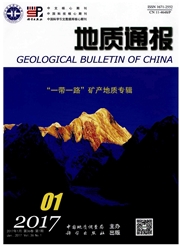

 中文摘要:
中文摘要:
以云蒙山变质核杂岩东侧的河防口低角度正断层为研究对象,通过矿物(黑云母)的变形特征和形成环境分析,获得了该断层带上的构造热演化环境:温度为780~860℃,压力约为7.3×10^8-8.6×10^8pa。提出云蒙山变质核杂岩的成因机制是,在区域伸展背景下,处于半固结状态的云蒙山花岗岩在东南侧卷入河防口-水峪伸展型韧性剪切带,使花岗岩发生中高温条件的韧性变形;之后,该韧性剪切带在隆升过程中不断向浅层次过渡,形成了一些浅层次的脆性伸展变形构造。
 英文摘要:
英文摘要:
In this paper the He(angkou low-angle detachment fault on the east side of the Yunmeng Shah metamorphic core complex is chosen as the object of research. According to the deformation features and formation environment of biotite (which is the main mineral of foliation and lineation in the Hefangkou ductile shear zone), the temperature and pressure conditions for the tectono-thermal evolution at the fault zone were 780-860℃ and -0.73-0.86 GPa. The genetic mechanism for the metamorphic core complex is as foUows: in the setting of regional extension, the semi-solid Yunmeng Shan granite was involved in the Hefangkou-Shuiyu extensional ductile shear zone at the southeast side, thus resulting in ductile deformation of granites under intermediate- to high-temperature conditions, and afterward, this ductile shear zone passed progressively to the shallow level in the uplift process, forming some shallow-level brittle extensional structures.
 同期刊论文项目
同期刊论文项目
 同项目期刊论文
同项目期刊论文
 Discovery of Cu-Ni-Zn-Sn-Fe intermetallic compounds and S-bearing alloys in the Zhaishang gold depos
Discovery of Cu-Ni-Zn-Sn-Fe intermetallic compounds and S-bearing alloys in the Zhaishang gold depos Constraints on the depth, geometry and kinematics of blind detachment faults provided by fault propa
Constraints on the depth, geometry and kinematics of blind detachment faults provided by fault propa Types, Characteristics, and Geodynamic Settings of Mesozoic Epithermal Gold Deposits in Eastern Chin
Types, Characteristics, and Geodynamic Settings of Mesozoic Epithermal Gold Deposits in Eastern Chin Tectonic significance of Late Triassic post-collisional lamprophyre dykes from the Qinling Mountains
Tectonic significance of Late Triassic post-collisional lamprophyre dykes from the Qinling Mountains Geochemistry and Nd-Sr isotopic studies of Late Mesozoic granitoids in the southeastern Hubei Provin
Geochemistry and Nd-Sr isotopic studies of Late Mesozoic granitoids in the southeastern Hubei Provin Re-Os molybdenite and 40Ar-39Ar phlogopite dating of Cu-Fe-Au-Mo (W) ore deposits in southeastern Hu
Re-Os molybdenite and 40Ar-39Ar phlogopite dating of Cu-Fe-Au-Mo (W) ore deposits in southeastern Hu SHRIMP zircon U-Pb dating of the intrusives in the Tongling metallogenic cluster and its dynamic set
SHRIMP zircon U-Pb dating of the intrusives in the Tongling metallogenic cluster and its dynamic set Molybdenite Re-Os and albite 40Ar/39Ar dating of Cu-Au-Mo and magnetite porphyry systems in the Yang
Molybdenite Re-Os and albite 40Ar/39Ar dating of Cu-Au-Mo and magnetite porphyry systems in the Yang Tectonic implications from Re Os dating of Mesozoic molybdenum deposits in the East Qinling Dabie or
Tectonic implications from Re Os dating of Mesozoic molybdenum deposits in the East Qinling Dabie or Precise Re-Os dating of molybdenite from the east Qinling molybdenum belt in central China and its g
Precise Re-Os dating of molybdenite from the east Qinling molybdenum belt in central China and its g SHRIMP Zircon U-Pb and Molybdenite Re-Os Datings of the Superlarge Donggou Porphyry Molybdenum Depos
SHRIMP Zircon U-Pb and Molybdenite Re-Os Datings of the Superlarge Donggou Porphyry Molybdenum Depos SHRIMP zircon U-Pb dating for volcanic rocks of the Dasi Formation in southeast Hubei Province, midd
SHRIMP zircon U-Pb dating for volcanic rocks of the Dasi Formation in southeast Hubei Province, midd Geology and geochemistry of telluride bearing Au deposits in the Pingyi area, Western Shandong, Chin
Geology and geochemistry of telluride bearing Au deposits in the Pingyi area, Western Shandong, Chin The relationship of mantle-derived fluids to gold metallogenesis in the Jiaodong Peninsula: Evidence
The relationship of mantle-derived fluids to gold metallogenesis in the Jiaodong Peninsula: Evidence P-T conditions of the crystallization and origin of plagioclase-mantled alkli feldspar megacrysts in
P-T conditions of the crystallization and origin of plagioclase-mantled alkli feldspar megacrysts in Kübler index and K-Ar ages of illite in Yinshan polymetallic deposit, Dexing, Jiangxi Province, Sout
Kübler index and K-Ar ages of illite in Yinshan polymetallic deposit, Dexing, Jiangxi Province, Sout 期刊信息
期刊信息
